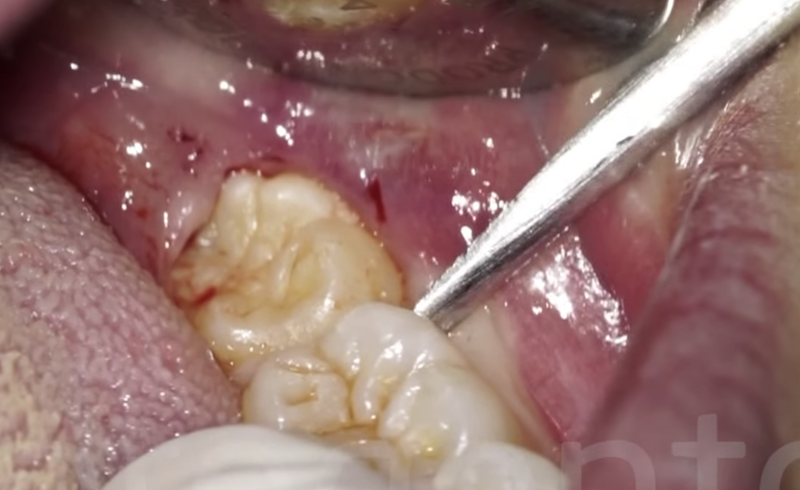
Problems with wisdom teeth cause acute pain at any age. Often they have to be removed. Let’s see if it is possible to perform a painless extraction.
In the past it was thought that late eruption of wisdom teeth could preclude the alignment of other teeth, or even cause a misalignment. Today it has been shown that the wisdom tooth alone is unable to cause the misalignment of the anterior teeth. This occurs regardless of the presence of the wisdom teeth. Masticatory forces cause misalignments.
Crooked teeth, although being more difficult to reach with the toothbrush, can easily be attacked by the bacteria that cause decay and cavities. However it must also be said that if a wisdom tooth is crooked and inclined towards the previous one, it almost always risk to cause a decay in that tooth. This kind o caries are often difficult to treat. In these cases it is recommended to extract the wisdom tooth as a preventive measure.
It is proven that the wisdom tooth is unnecessary for chewing so when it represents a problem the first thought is to extract it. In fact, the chewing process involves all the teeth up to the seventh one. The self–
As oral hygiene is difficult at the level of the wisdom tooth, infections and gum inflammation may occur. Fever and sore throat are also possible (lower third molar dysodontiasis).
When a wisdom tooth hurts, the pain is due to a decay that reached the pulp chamber (the nerve) or to the inflammation of the gum around the tooth. In the latter case the symptoms are generally gum swelling and pain. But also earache, difficulty in swallowing and the inability to open the mouth very wide. In case of necrotic tissues, bad breath could be caused by abscesses or sores.
At what age do wisdom tooth-related problems show?
The first problems related to the wisdom tooth are due to its eruption which usually begins in adolescence, around 17 years old. Cases requiring extraction have a wider age variable from around 35 years, up to 50 and in some cases even 60 years.
Wisdom tooth and pain, what to do?
We usually recommend patients at the initial stage of the wisdom tooth eruption, who experience moderate pain, avoiding hard, cold and hot food. When the pain increases you can take an analgesic, but don’t exceed the recommended dose – remember, analgesics only have effect on the symptoms.
Some suggest keeping the gums clean by rubbing them with a cotton wool wad soaked with hydrogen peroxide, or doing the same thing with a syringe without needle. Usually, however, in absence of specific problems, the pain disappears in a few days. When pain is not caused by the natural and physiological development of the wisdom tooth, it could depends on infections or on orthodontic-related problem. In this cases the only remedy is to schedule a visit to the dentist who will evaluate the situation and decide what to do.
When should the wisdom tooth be removed?
Sometimes it is necessary to remove it because it can obstruct the mouth completely. Apart from the burning sensation caused by infections it can even damage the surrounding teeth or tissues. It could even cause holes or serious injuries to gums or cheeks. When such a risky situation occurs, you need to extract it.
Wisdom tooth removal – how is it usually performed?
Wisdom tooth extraction is usually carried out as for that of any other permanent tooth. Dental forceps are used to tilt the tooth in its alveolus. The applied force loosens the gum intake and allows the extraction. The problem with this canonical technique is that its application often causes a fracture of the tooth. This entail the an operating session that can last up to two hours. This would be the time necessary to remove all the fragments of the broken tooth from the alveolus. Is not infrequent, after the problematic extraction of a wisdom tooth, the occurrence of alveolitis, i.e. the inflammation of the alveolar bone, the bone cavity in which the roots of the teeth are housed.
Wisdom tooth extraction in a few minutes
A fracture occurs when the the forceps move the tooth towards a “lateral” direction. There is, however, a technique – we use in our study – which allows you to extract the wisdom teeth without forceps, using elevators.
Using the elevator instead of the forceps, allows you to push the tooth directly from the bottom to the top, with no lateral movements. The patient will be extremely satisfied with the quick wisdom tooth removal. A painless extraction. Above all, there are no major complications because using levers will avoid breaks, so there will be no residual fragments.
This technique is less traumatic, painless, quick and safe. Therefore we recommend it to all our patients and in general to everyone requiring the extraction of a tooth.



Scrivi un commento: